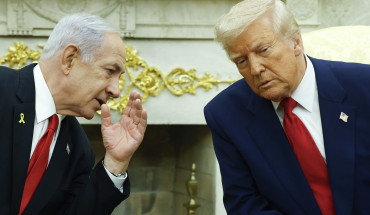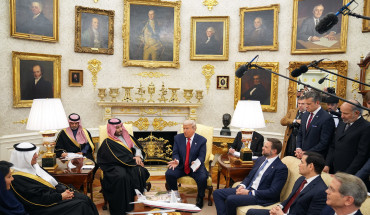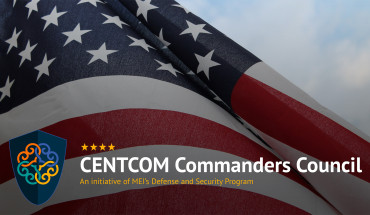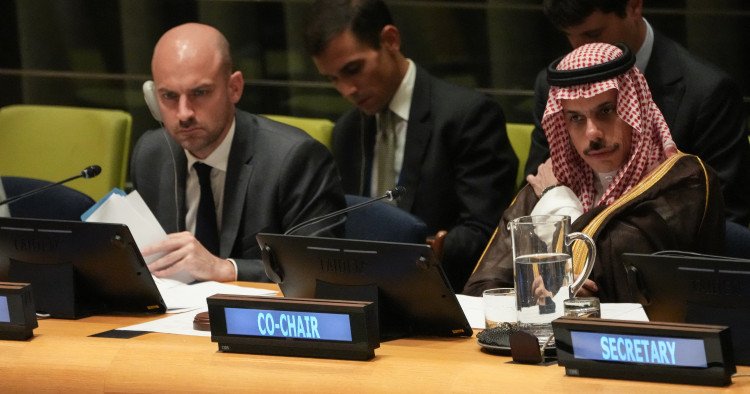The Hamas attack on Oct. 7, 2023, shattered Israel’s long-standing security paradigm, replacing limited deterrence with an ambitious campaign aimed at dismantling Hamas, confronting Hizballah and other Iranian proxies, and directly targeting Iran’s nuclear program with the support of the United States. In stark contrast, Saudi Arabia has prioritized regional stability and de-escalation, restoring relations with Iran, and focusing on its Vision 2030 economic transformation. These divergent paths — Israel’s military maximalism versus Saudi Arabia’s pursuit of stability — have frozen normalization talks and complicated US diplomacy.
Israel’s shift: From “mowing the lawn” to maximalist confrontation
For more than a decade, Israel relied on periodic strikes — the so‑called “mowing the lawn” strategy — to degrade Hamas and temporarily restore deterrence without resolving Gaza’s underlying crisis. The Oct. 7 attack, however, exposed the limits of that approach, revealing Hamas’s growing operational capabilities and Israel’s vulnerability.
In response, Israeli leaders abandoned containment in favor of open-ended military operations aimed at dismantling Hamas and degrading Iran’s regional network. This strategy quickly expanded geographically, marked by intensified strikes on Hizballah and Iran-linked sites in Syria, occasional operations against the Houthis in Yemen, and unprecedented direct attacks on Iranian nuclear facilities. What had been a shadow conflict with Iran became overt and kinetic, with the United States joining Israeli strikes on Iranian targets in June 2025.
This dual-track approach — open-ended destruction in Gaza but calibrated containment elsewhere — creates a more complex and volatile security environment. Stepped-up military operations across multiple fronts increase the risk of unintended clashes and rapid escalation; Israeli strikes in Lebanon, Syria, and Iran, while constrained, nonetheless amount to a multi-front war; and the broader geographic scope makes escalation dynamics harder to control or de-escalate.
In essence, Israel is trying to replace a localized, cyclical “mowing the lawn” in Gaza with a maximalist, decisive campaign, while simultaneously expanding the concept regionally to continuously degrade a constellation of Iranian proxies through periodic, limited actions. This layered approach acknowledges both the political and military limits in Lebanon and Iran but increases the overall regional risk profile, making the strategic environment more unstable and unpredictable than before.
Saudi Arabia’s strategic anxiety and domestic constraints
Saudi Arabia’s reaction to Israel’s post-Oct. 7 strategy has blended vocal public condemnation with careful strategic positioning, reflecting a complex balancing act between external pressures and internal challenges. Publicly, Riyadh has condemned Israel’s Gaza campaign, decried civilian casualties, and reaffirmed support for the Palestinian cause and a two-state solution. Through hosting regional summits and issuing high-profile statements, the kingdom has sought to project itself as a defender of Palestinian rights.
Privately, however, Saudi leaders harbor little sympathy for Hamas or Hizballah, both viewed as Iranian proxies, while expressing alarm at Israel’s open-ended confrontation strategy. Regional stability is essential to Vision 2030 — the kingdom’s ambitious plan to diversify its economy and attract foreign investment. This imperative, together with frustration over what it perceived as a lukewarm US response to the September 2019 attacks on its oil infrastructure, likely led Riyadh to restore diplomatic relations with Iran in March 2023, signaling a shift toward de-escalation.
That caution was evident in Riyadh’s resistance to the US bombing campaign in Yemen both during the latter months of President Joe Biden’s administration and ahead of President Donald Trump’s May visit to the kingdom — a stance contrary to Israel’s preferences. It also extended to security cooperation where Riyadh reportedly rebuffed a US request to transfer missile interceptors to Israel during June’s 12-day war, signaling reluctance to be seen as facilitating Israeli operations and underscoring the limits of US leverage when Saudi domestic and regional priorities are at stake.
Further reflecting its desire to contain escalation, in mid-July Riyadh joined Arab neighbors and Turkey in condemning Israeli airstrikes in Syria, reinforcing its opposition to open-ended regional escalation. Amid worsening famine in Gaza, Saudi Arabia two weeks later co-chaired a United Nations conference with France — boycotted by the US and Israel — at which 17 states, the European Union, and the Arab League endorsed a declaration condemning the Oct. 7 attack, calling for Hamas’s disarmament and transfer of Gaza to the Palestinian Authority, and renewing support for a two-state solution. Israel’s immediate rejection of this initiative, as articulated by Foreign Minister Gideon Sa’ar, highlighted the gulf between Riyadh’s diplomatic de‑escalation agenda and Israel’s military-centric approach.
The stakes for Saudi Arabia are considerable. The 2019 Abqaiq and Khurais attacks exposed its vulnerability, a concern heightened by the post–Oct. 7 spread of conflict to direct Israel–Iran confrontations — raising fears of being drawn into war and jeopardizing both Vision 2030 and global energy markets. Israel’s maximalist military strategy — extending beyond Hamas to Hizballah and Iranian targets — deepens these risks by making escalation systemic rather than episodic.
While Saudi Arabia has no interest in shielding Iranian proxies, it has even less interest in becoming collateral damage in a widening conflict it neither initiated nor controls. If Israel’s security paradigm prioritizes open‑ended confrontation, Riyadh is likely to maintain distance, emphasize de‑escalation, and seek diplomatic leverage to contain the fallout. But Saudi policy is not shaped by external dynamics alone; it is also bounded by domestic legitimacy and religious leadership considerations, which impose their own constraints.
The divergence between Riyadh and Tel Aviv is therefore not just tactical but conceptual. Israel seeks security through dominance, projecting military power as a means of reshaping regional dynamics. Saudi Arabia, by contrast, seeks security through equilibrium, believing that its ambitious Vision 2030 transformation requires a predictable environment insulated from geopolitical shocks.
For Riyadh, Israel’s approach signals the emergence of a deeply unsettling regional order — one in which Israeli military action sets the terms while Arab diplomacy is sidelined, Palestinian rights ignored, and Saudi-led peace initiatives dismissed out of hand. Yet the threat Riyadh perceives is not merely external. Saudi power rests on its credibility as the guardian of Islam’s holiest sites and as the standard-bearer for Arab interests. A regional order in which Israeli military action becomes the default instrument for setting terms while Arab voices are marginalized strikes at the heart of the monarchy’s legitimacy.
Domestic legitimacy and symbolic obligations heighten these anxieties. As custodian of Islam’s holiest sites, Saudi Arabia bears unique religious and symbolic responsibilities. Outrage over Israeli military actions in Gaza and provocative actions by extremist members of the Israeli government at religious sites in Jerusalem reverberate deeply within domestic society as well as across the broader Muslim world, generating pressure on the government to maintain a vociferous rhetorical and diplomatic stance against Israel. Against this backdrop, overt normalization with Israel has become politically toxic, particularly absent tangible progress toward Palestinian statehood.
Vision 2030’s social liberalization agenda — from loosening religious restrictions to expanding tourism and entertainment — has unsettled some conservatives. For many, vocal support for Palestine has become both a reaffirmation of Islamic identity and a vehicle for expressing unease with domestic reforms. If Riyadh were perceived as acquiescing to Israeli impunity, public disappointment could shift to defiance, threatening the social compact underpinning the kingdom’s reform process.
This stands in marked contrast to the United Arab Emirates, which normalized relations with Israel through the Abraham Accords in 2020 and has since prioritized bilateral economic, security, and technology cooperation. The UAE’s smaller population, tightly controlled political environment, and absence of custodial religious obligations limited domestic constraints. Abu Dhabi framed normalization as a strategic opportunity to secure US favor, attract investment, and expand influence in emerging sectors.
Faced with these pressures, Saudi leaders have doubled down on de-escalation as their guiding principle — combining public criticism of Israeli actions with humanitarian initiatives while avoiding steps that could draw the kingdom into open confrontation. This balancing act highlights Riyadh’s determination to shield its economic transformation and regional diplomacy from the destabilizing effects of Israel’s expanded military campaign.
However, despite this approach, Saudi leaders likely remain wary of being trapped between an Israel bent on maximalist military solutions and an Iranian regime adept at exploiting regional crises. Riyadh’s calculations are therefore defensive as well as aspirational: avoid entanglement in conflicts it does not control, maintain its credibility as the guardian of Muslim interests, and preserve the domestic space required for social and economic transformation.
In this sense, normalization with Israel under current conditions is not just politically costly but strategically self-defeating. Until Israel signals a genuine willingness to temper its military escalation and commit to meaningful political accommodation with the Palestinians, Saudi anxieties will remain unassuaged, normalization will remain frozen, and the region will continue to teeter between fragile diplomacy and renewed instability.
Implications for US policy
The widening gap between Israel’s assertive military campaigns and Saudi Arabia’s cautious pursuit of regional stability presents a multifaceted challenge for US policymakers. For decades, Washington has viewed Saudi-Israeli normalization as a strategic linchpin for consolidating a US-aligned regional bloc capable of counterbalancing Iran and reducing American security burdens. Prior to Oct. 7, momentum appeared strong, with Washington actively mediating exploratory talks designed to pair normalization with security guarantees, advanced arms sales, and civil nuclear cooperation for Riyadh.
Israel’s post-attack military maximalism, however — marked by expanded operations deep inside Iran and against its proxies — has intensified Saudi anxieties about regional destabilization. As a result, US efforts to secure a trilateral deal have encountered mounting resistance, undermining Washington’s mediation leverage and regional credibility.
Navigating this environment forces the United States to balance difficult policy dilemmas. Attempting to combine robust security guarantees, advanced arms sales, and nuclear cooperation for Saudi Arabia with rhetorical support for Palestinian rights and calls for Israeli restraint risks contradictory outcomes. Pushing normalization without tangible progress on the Palestinian question could further alienate Arab publics and erode American soft power, while endorsing Israel’s military maximalism risks deepening rifts with Gulf partners and fueling broader regional instability.
The fragmentation also affects security cooperation and burden-sharing initiatives. Saudi mistrust of Israel’s confrontation strategy has arguably slowed efforts to build integrated regional air and missile defenses, intelligence-sharing arrangements, and collective deterrence mechanisms.
Economic and energy diplomacy faces similar constraints. Saudi Arabia’s Vision 2030 goals — and its role as a reliable global energy supplier — depend heavily on market stability and investor confidence, both of which are threatened by persistent regional volatility linked to Israeli military actions. Riyadh’s independent moves in energy policy, coupled with deeper economic ties to China and diversification of foreign investment sources, serve as hedges against political risks associated with alignment with US-Israel policies.
In sum, the divergence between Israel’s security posture and Saudi Arabia’s stability-oriented strategy is more than a temporary disagreement over methods. It signals a structural shift in regional alignments that constrains US diplomacy. Washington’s longstanding aim to build a predictable, cooperative Middle East anchored on Israeli military strength and Saudi economic leadership now faces immense obstacles. Without bridging these conflicting priorities — chiefly through credible mechanisms for crisis de-escalation and meaningful progress on the Palestinian issue — America’s ability to unify its partners, manage crises, and maintain regional stability will continue to diminish.
Conclusion
The Saudi-Israeli divide is not a temporary dispute over methods but a clash of strategic visions, one of which is rooted in dominance and rapid military action, with the other in stability and gradual transformation. The Oct. 7 Hamas attack pushed Israel from its “mowing the lawn” paradigm to an open-ended campaign against Hamas and Iran’s regional network. For Saudi Arabia, this shift is troubling. Although the kingdom shares Israel’s opposition to Iranian influence, it also fears the destabilizing fallout of expanded Israeli operations, particularly direct strikes on Iran. Vision 2030’s success depends on regional stability; and as custodian of Islam’s holiest sites, Riyadh faces strong domestic and pan-Islamic pressures to condemn Israeli actions and back the Palestinian cause. These constraints, coupled with anxieties over Israeli assertiveness, make normalization politically untenable without tangible progress on Palestinian statehood and credible security assurances.
For the United States, this divergence stalls one of its signature regional initiatives and complicates its broader strategy of consolidating alliances to counter Iran and China. With normalization talks frozen, humanitarian crises mounting, and the risk of regional escalation persisting, Washington faces a Middle East where its closest partners are pursuing fundamentally different priorities: Israel doubling down on military preemption and Saudi Arabia emphasizing de-escalation and economic transformation. Until that gap is bridged — through progress on the Palestinian issue and credible regional security assurances — US diplomacy will remain constrained, and the risk of destabilizing confrontation will endure.
John Calabrese is a senior fellow at the Middle East Institute (MEI) and book review editor for The Middle East Journal.
Photo by Timothy A. Clary/AFP via Getty Images
The Middle East Institute (MEI) is an independent, non-partisan, non-for-profit, educational organization. It does not engage in advocacy and its scholars’ opinions are their own. MEI welcomes financial donations, but retains sole editorial control over its work and its publications reflect only the authors’ views. For a listing of MEI donors, please click here.













